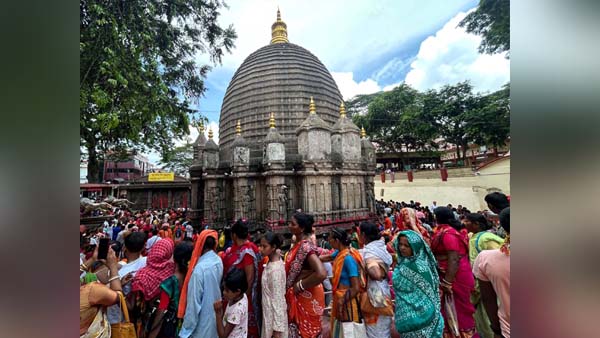By Satyabrat Borah
The Ambubachi Mela, held annually at the Kamakhya Temple atop the Nilachal Hill in Guwahati, Assam, is one of India’s most significant spiritual and cultural festivals. Celebrated during the monsoon month of June, typically beginning on the seventh day of the Assamese month of Ahaar, this four-day event draws devotees, sadhus, tantrics, and spiritual seekers from across India and beyond. Rooted in the ancient traditions of Shaktism and Tantra, the Ambubachi Mela is a profound celebration of divine feminine energy, fertility, and the interconnectedness of human life with nature. Its spiritual significance is multifaceted, encompassing devotion to the goddess Kamakhya, tantric practices, reverence for nature, and the recognition of the sacredness of womanhood. This essay explores the deep spiritual dimensions of the Ambubachi Mela, highlighting its role as a unique confluence of faith, mysticism, and cultural unity.
At the heart of the Ambubachi Mela lies the Kamakhya Temple, one of the 51 Shakti Peethas, sacred sites associated with the goddess Sati in Hindu mythology. According to legend, when Sati’s body was dismembered by Lord Vishnu to pacify the grief-stricken Lord Shiva, her yoni (womb) fell at Nilachal Hill, making it a potent center of Shakti worship. Unlike most temples where deities are worshipped in anthropomorphic forms, the Kamakhya Temple venerates the goddess as a yoni-shaped stone, symbolizing creation, fertility, and the divine feminine. The term “Ambubachi” derives from the Sanskrit words “ambu” (water) and “bachi” (flow or sprouting), signifying the life-giving essence of water and the fertility of the earth. During the Ambubachi Mela, it is believed that Goddess Kamakhya undergoes her annual menstrual cycle, a period when the temple remains closed for three days. On the fourth day, after special rituals and purification ceremonies, the temple reopens, marking the beginning of the vibrant mela. This unique reverence for the goddess’s menstruation underscores the festival’s spiritual core, celebrating the creative and nurturing power of the feminine.
The spiritual significance of the Ambubachi Mela is deeply tied to Shaktism, a Hindu tradition that worships the divine feminine as the ultimate source of cosmic energy. Kamakhya is revered as the goddess of desire, fertility, and empowerment, embodying the primal energy (Shakti) that sustains life. The festival is a time when devotees seek her blessings for prosperity, spiritual growth, and liberation. The closure of the temple during the goddess’s menstruation is not seen as a period of impurity but as a sacred time when her divine energy is at its peak. Devotees believe that the earth, personified as the goddess, is in a state of rest and rejuvenation during these three days. The temple’s reopening signifies her return to accessibility, showering devotees with her grace. The Ambubachi cloth, a piece of red cloth believed to be moistened by the goddess’s menstrual blood, is distributed as a sacred offering. This cloth is considered highly auspicious, symbolizing the goddess’s blessings and her life-giving power.
The Ambubachi Mela is also a significant occasion for tantric practitioners, as Kamakhya is one of the most important centers of Tantra in India. Tantrism, a spiritual tradition that seeks to harness divine energy through esoteric rituals, finds a fertile ground during this festival. Sadhus, ascetics, and tantrics from across the country converge at Nilachal Hill to engage in meditation, mantra recitation, and complex rituals aimed at attaining spiritual enlightenment. The festival’s atmosphere is charged with mysticism, as these practitioners perform secretive ceremonies to connect with the divine feminine energy. The belief that the Brahmaputra River turns red during Ambubachi, symbolizing the goddess’s menstruation, adds to the mystical aura. Though this phenomenon may have natural explanations, such as iron-rich soil washing into the river during the monsoon, for devotees, it is a divine sign of the goddess’s presence and power. The Ambubachi Mela thus serves as a spiritual crucible where the boundaries between the material and the divine blur, offering practitioners a unique opportunity to transcend worldly limitations.
Beyond its religious and tantric dimensions, the Ambubachi Mela carries profound spiritual significance in its reverence for nature and the cycles of life. In Assam’s agrarian society, the festival is closely linked to the rhythms of the natural world. During Ambubachi, agricultural activities such as plowing, sowing, and harvesting are traditionally paused, reflecting the belief that Mother Earth, like the goddess, is in a state of rest during her menstruation. This practice underscores the festival’s deep ecological consciousness, emphasizing the need to honor and protect the earth. The rituals observed during Ambubachi, such as abstaining from cooking by certain groups and purifying household items, reinforce the idea of spiritual and physical cleansing. These customs highlight the interconnectedness of human life with the environment, encouraging devotees to live in harmony with nature. The festival thus becomes a spiritual reminder of humanity’s responsibility to preserve the earth’s sanctity and fertility.
The Ambubachi Mela also fosters a sense of spiritual and social unity, bringing together people from diverse backgrounds. Devotees from different castes, communities, and regions gather at Kamakhya, creating a vibrant tapestry of faith and devotion. The festival transcends social barriers, as sadhus, householders, and pilgrims share the same sacred space, united by their reverence for the goddess. The mela’s festive atmosphere, with its colorful stalls, devotional music, and communal prayers, creates a sense of collective spirituality. This unity is further amplified by the participation of international devotees, who are drawn to the festival’s unique blend of mysticism and devotion. The Ambubachi Mela thus serves as a spiritual melting pot, where diverse traditions and beliefs converge in a shared celebration of the divine feminine.
One of the most remarkable aspects of the Ambubachi Mela is its celebration of womanhood and the sanctity of female biological processes. In many cultures, menstruation is stigmatized or considered impure, but the Ambubachi Mela elevates it to a divine act. By venerating the goddess’s menstruation, the festival challenges patriarchal norms and affirms the sacredness of women’s bodies. This reverence for the feminine extends beyond the spiritual realm, influencing social attitudes and fostering respect for women. The festival’s emphasis on fertility and creation underscores the vital role of women in sustaining life, both biologically and spiritually. For many devotees, particularly women, attending the Ambubachi Mela is an empowering experience, as it validates their identity and their connection to the divine feminine. This aspect of the festival makes it a powerful statement of gender equality and spiritual inclusivity.
The spiritual practices observed during the Ambubachi Mela also emphasize inner purification and self-discipline. Devotees undertake fasting, meditation, and other austerities to cleanse their minds and bodies, preparing themselves to receive the goddess’s blessings. The consumption of raw milk during the festival, believed to ward off snakebites, reflects the integration of local folklore with spiritual practices, reinforcing the connection between the physical and metaphysical worlds. The rituals performed during Ambubachi, such as offering flowers, incense, and prayers, are not merely external acts but pathways to inner transformation. For many, the festival is a time to reflect on their spiritual journey, seek forgiveness for past transgressions, and renew their commitment to a life of righteousness.
The Ambubachi Mela’s spiritual significance is further enriched by its historical and cultural context. The Kamakhya Temple has been a center of worship for centuries, attracting devotees from ancient times to the present day. Its location in Assam, a region known for its syncretic blend of Hindu, tribal, and Buddhist traditions, adds to the festival’s unique character. The mela is not only a religious event but also a cultural celebration, showcasing Assam’s rich heritage through music, dance, and traditional crafts. The festival’s ability to preserve and promote these traditions while remaining a vibrant spiritual event speaks to its enduring relevance.
The Ambubachi Mela is a profound spiritual event that encapsulates the essence of Shaktism, Tantra, and reverence for nature and womanhood. It is a celebration of the divine feminine, a time for inner purification, and a testament to the unity of diverse communities. By honoring the goddess’s menstruation, the festival challenges societal taboos and affirms the sacredness of life’s natural processes. Its mystical atmosphere, rich rituals, and ecological consciousness make it a unique spiritual experience that resonates with devotees and seekers alike. Held in the sacred precincts of the Kamakhya Temple, the Ambubachi Mela continues to inspire millions, serving as a powerful reminder of the divine feminine’s role in sustaining the universe and the interconnectedness of all life. Through its celebration of faith, nature, and humanity, the mela remains a beacon of spiritual and cultural heritage, illuminating the path to divine connection and self-realization.




